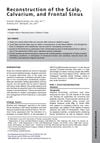The Composite Galeal Frontalis Pericranial Flap Designed for Anterior Skull Base Surgery
August 2008
in “
Plastic & Reconstructive Surgery
”
TLDR The flap effectively sealed leaks and served as a barrier, with minor complications, for anterior skull base surgery.
The composite galeal frontalis pericranial flap was designed for anterior skull base surgery to address limitations of the traditional pericranial flap, particularly in providing a barrier between the nasal cavity and brain. This flap was used in 7 operations and featured a narrow pedicle that included the supratrochlear arteries while excluding the supraorbital nerve and artery to avoid numbness and skin necrosis. The flap was harvested with careful dissection to prevent damage to hair follicles and postoperative alopecia. It effectively sealed cerebrospinal fluid leaks and served as a barrier between the nasopharynx and intracranial space. Complications included mild glabella depression in 2 patients and temporary visual disability in 5 patients, which resolved within a month. The flap was not suitable for massive cranial base defects but was successful for reconstruction over the nasal cavity ceiling. The study proposed this flap as an alternative for minimally invasive anterior cranial base surgery, achieving functional and aesthetic success except for expected anosmia.




